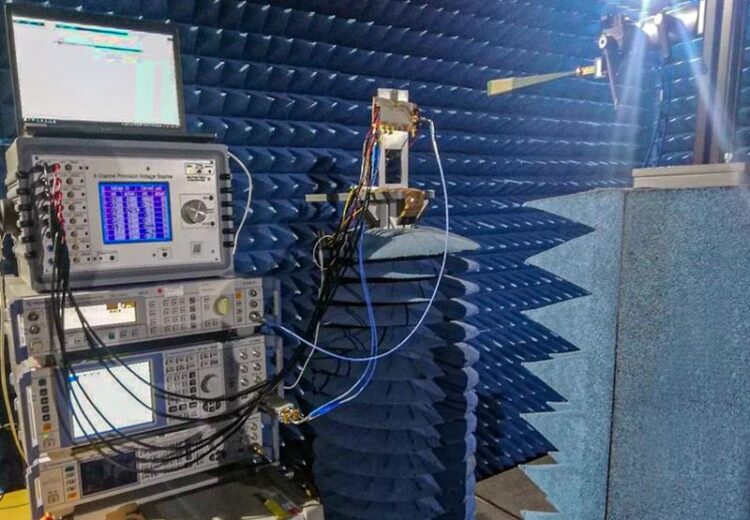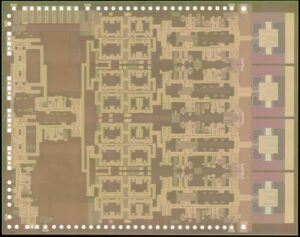World record for IHP circuit

Transferring data at 200 gigabits per second.
Researchers at IHP – Leibniz Institute for High Performance Microelectronics have set a new world speed record. The circuit designed by the scientists in Frankfurt (Oder) can transmit data wirelessly at up to 200 gigabits per second.

(c) IHP
Researchers at IHP – Leibniz Institute for High Performance Microelectronics have set a new world speed record. The circuit designed by the scientists in Frankfurt (Oder) can transmit data wirelessly at up to 200 gigabits per second. This sur-passes the previous record, last published in 2019, which was around 120 gigabits per second. The results of the development have been published in the prestigious “IEEE Journal of Solid-State Circuits” magazine, after being peer-reviewed by experts. A re-search team at IHP has thus proven for the first time worldwide the general feasibility of extremely high data transmissions in the so-called D-band (frequencies between 110 and 170 GHz) and created a basic prerequisite for realising applications for the next generation of mobile communication (6G).
A breakthrough has been achieved by IHP scientist Alper Karakuzulu and his research group led by Dr Andrea Malignaggi. The experts in communication circuits of the high-est data rates have developed a new chip within the 130 nm SiGe BiCMOS technology that contains transmitter, receiver and on-chip antennas and enables data transmis-sion of 200 gigabits per second. “Our design was simulated down to the last detail be-fore the circuit went into production,” explains Dr Andrea Malignaggi.
The microchips manufactured in the IHP clean room were then extensively tested, and their perfor-mance measured in the IHP’s antenna measurement chamber, where there is no dis-tracting radiation. The result, transmission over an initial range of 15 centimetres, is the basis for further development of the technology.
“To be able to realise 6G for mobile communications, we need a completely new architecture. Picocells are an example of this. These radio cells should enable very high data rates at short distances, e.g. in con-ference rooms or in private areas when mobile phones, televisions and other devices are networked together,” explains Dr Andrea Malignaggi.
Through the further devel-opment of the integrated components and circuit blocks of the individual chip, the integration of additional antennas and the combination of several microchips into complex systems, it will be possible in the future to transmit data ultra-fast even over a greater distance.
IHP is currently contributing its expertise to two important research projects in the field of 6G development. The EU project “Open6GHub – 6G for Society and Sustainabil-ity” aims to contribute to a global 6G harmonisation process and standard in a Europe-an context. The 6G Research and Innovation Cluster, or 6G-RIC for short, is a research hub designed to lay the scientific and technical foundations for 6G across all technology levels, from radio access to core networks and fiber optic transport networks. With its research, IHP is thus making an important contribution to strengthening Germany’s and Europe’s technological sovereignty and position in the international competition for 6G.
Originalpublikation:
Media Contact
All latest news from the category: Information Technology
Here you can find a summary of innovations in the fields of information and data processing and up-to-date developments on IT equipment and hardware.
This area covers topics such as IT services, IT architectures, IT management and telecommunications.
Newest articles

Sea slugs inspire highly stretchable biomedical sensor
USC Viterbi School of Engineering researcher Hangbo Zhao presents findings on highly stretchable and customizable microneedles for application in fields including neuroscience, tissue engineering, and wearable bioelectronics. The revolution in…

Twisting and binding matter waves with photons in a cavity
Precisely measuring the energy states of individual atoms has been a historical challenge for physicists due to atomic recoil. When an atom interacts with a photon, the atom “recoils” in…

Nanotubes, nanoparticles, and antibodies detect tiny amounts of fentanyl
New sensor is six orders of magnitude more sensitive than the next best thing. A research team at Pitt led by Alexander Star, a chemistry professor in the Kenneth P. Dietrich…





















